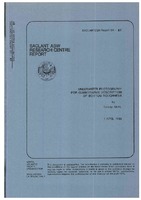| dc.description.abstract | Knowledge of the roughness of the sea floor is obviously of great importance in marine geology for understanding the processes of the ocean bottom, and in underwater acoustics for understanding the scattering process. The ocean bottom contains a wide spectrum of roughness, ranging from a few millimeters to several kilometers, where small features are superimposed on much larger topographic features (Akal, 1984). This complex structure, formed by different physical, chemical and biological forces, can be quantitatively described in terms of their statistical properties, i.e., power spectral density and autocorrelation functions. The gross-scale roughness of the sea floor is reasonably well known due to well-developed echo-sounding techniques. However, little is known about small-scale roughness (amplitudes and wavelengths ranging from centimeters to meters) due to the difficulties of measuring them. The major technique for studying this small-scale roughness is bottom topography. By using photogrammetric techniques, a single pair of overlapping photographs taken with stereo cameras can subsequently be used to provide fine-scale contour charts of the sea floor. To analyze these contoured charts quantitatively, a numerical method has been developed to calculate the two-dimensional bottom-roughness power-spectral density and autocorrelation functions. This information gives, quantitatively, two basic parameters of a rough surface: its amplitude and wavelength content and its orientation. These parameters are closely related to the type of sediment and to bottom currents and their direction, hence to the sedimentation, transportation, and erosion processes. This information is also the main parameter for modelling the acoustic bottom scattering and acoustic propagation process. | |
